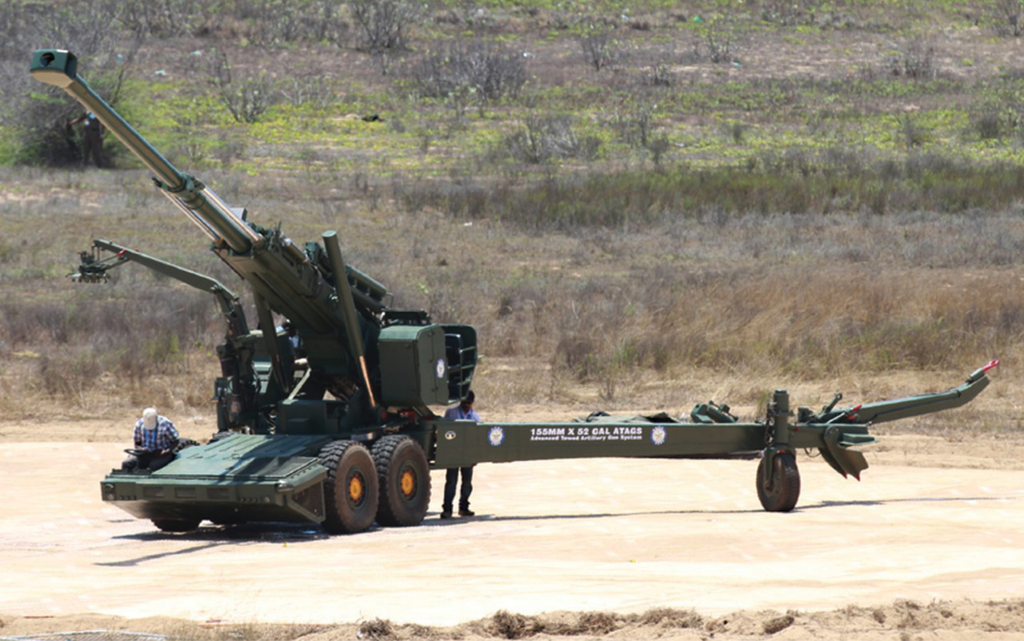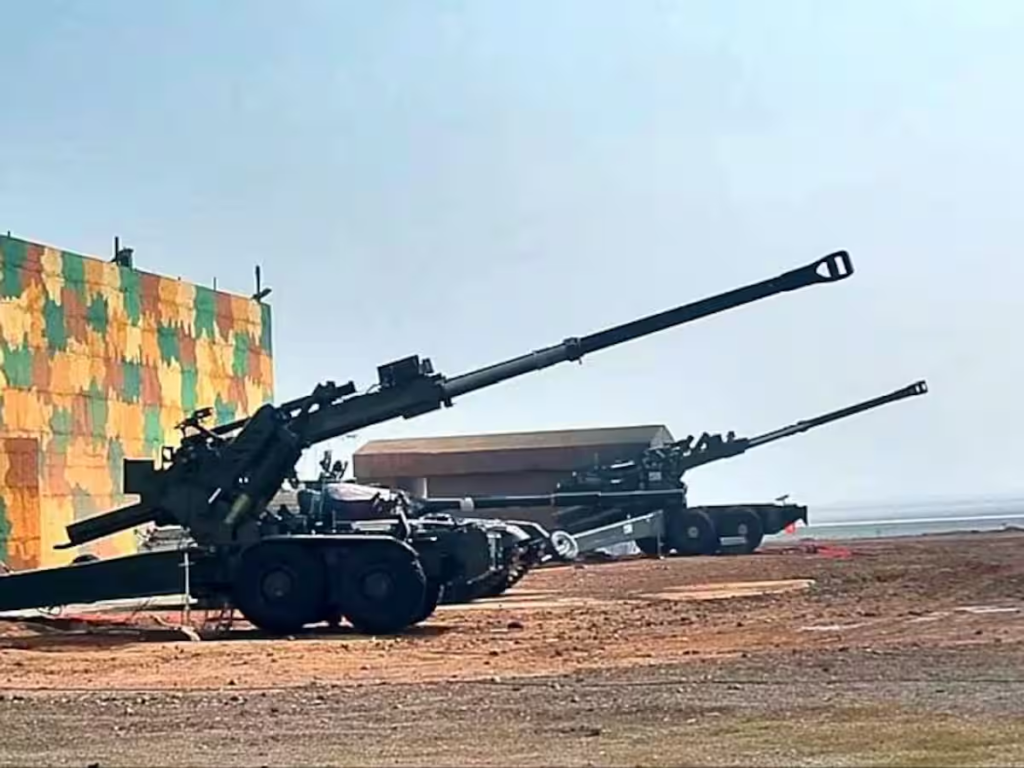The Indian Ministry of Defence has recently approved two critical Acceptance of Necessity (AoN) programs for towed artillery gun systems. One is for 307 guns, and the other for 400 guns. While the 307-gun requirement can be met by the Advanced Towed Artillery Gun System (ATAGS), the 400-gun order poses new challenges. This newer requirement emphasizes a maximum weight of 15 tonnes, which ATAGS exceeds with its 18-tonne weight.

To address this, the Defence Research and Development Organisation (DRDO) has designed a new, lighter gun system—the Advanced Light Towed Gun System (ALTGS). This system retains the core capabilities of the ATAGS while being significantly lighter. Let’s explore the development of the ALTGS, its significance, and how it compares to other potential candidates for the Indian Army’s artillery modernization program.
The Need for Lighter Artillery
India’s military modernization efforts have always focused on balancing firepower with mobility. The army’s requirements for the 400 new guns clearly underscore this balance. With a cap on weight at 15 tonnes, the need for a light but powerful artillery system becomes apparent. Heavy artillery can be difficult to transport, especially in rugged terrains or during rapid deployments. Hence, the new AoN specifies a lighter, more maneuverable system.

The ALTGS is the response to this challenge. It is designed to meet the army’s needs while maintaining the high level of firepower that has been achieved in the ATAGS. By reducing the weight while keeping most of the capabilities intact, the DRDO ensures that the ALTGS provides operational flexibility in various terrains.
Why ATAGS Does Not Fit the 400-Gun Requirement
The ATAGS is a highly capable artillery system. It boasts long-range precision, high rate of fire, and superior accuracy. However, its weight—approximately 18 tonnes—exceeds the limit set by the Indian Army for the 400-gun requirement. The army requires artillery that can be rapidly deployed, especially in high-altitude or rough-terrain areas where heavy guns would struggle.

The new demand for a 15-tonne system means the ATAGS can only meet the 307-gun requirement, which has no such weight cap. Despite this limitation, the ATAGS continues to be an excellent system for traditional operations, but the need for lighter guns like the ALTGS is clear for modern, fast-paced combat scenarios.
The Development of ALTGS
To meet the stringent demands of the 400-gun requirement, the DRDO developed the Advanced Light Towed Gun System (ALTGS). This system keeps many of the capabilities of the ATAGS while reducing its overall weight. The ALTGS weighs under 15 tonnes, making it lighter, more mobile, and easier to transport.

The design incorporates new materials and structural adjustments to maintain strength and firepower. Engineers focused on creating a system that would offer high mobility without sacrificing operational effectiveness. The ALTGS is designed to deliver similar range, accuracy, and rate of fire as the ATAGS, but with the added advantage of greater mobility. Its lighter weight enables faster movement in difficult terrains, which is critical for modern artillery units.
Why Lighter Guns Are Better for the Indian Army
The ALTGS brings several benefits to the Indian Army. First, its lighter weight makes it easier to transport, both by road and air. In regions like the Himalayas, where the terrain is tough and rapid mobility is crucial, a lighter gun will be a game changer. Second, the army can deploy the ALTGS more quickly and with less logistical support. This means the army can react faster to threats, enhancing its operational readiness.
Additionally, a lighter system reduces the wear and tear on vehicles used to transport the guns. This will decrease maintenance costs and extend the lifespan of supporting vehicles. As a result, the ALTGS could provide long-term cost savings, while still meeting the army’s firepower needs.
Competitors to ALTGS: Dhanush 52 and Bharat 52
The ALTGS is not the only system under consideration for the 400-gun requirement. Two other guns—Dhanush 52 and Kalyani’s Bharat 52—could potentially compete for the contract.
- Dhanush 52 is an upgunned version of the Dhanush howitzer. It offers enhanced firepower and range, making it a capable system. However, its makers aren’t able to sustain the orders of Dhanush 45 and this is a big red flag.
- Kalyani’s Bharat 52 is another option. This system is lighter than Dhanush 52 and offers good firepower. Still, it may not meet all of the Indian Army’s requirements as effectively as the ALTGS.
Both Dhanush 52 and Bharat 52 are strong contenders, but the army is also likely to consider the logistical benefits of having commonality between systems. The ALTGS builds on the existing ATAGS design, meaning that parts, training, and maintenance could be streamlined. This could make the ALTGS the preferred choice, as it would reduce the logistical burden on the army and simplify inventory management.
Commonality in Artillery Systems: A Strategic Advantage
One of the main advantages of the ALTGS is its commonality with the ATAGS. Using a gun system that shares components and capabilities with the ATAGS simplifies the supply chain. The Indian Army would not need to stock different spare parts for multiple artillery systems, making inventory management more efficient.
Furthermore, training soldiers on the ALTGS would be easier because of its similarity to the ATAGS. Crews trained on the ATAGS can easily transition to the ALTGS with minimal additional training. This will reduce training costs and ensure that soldiers are ready to use the new guns as soon as they are deployed.
Logistics and inventory management are often overlooked aspects of military operations, but they play a critical role in operational readiness. By choosing the ALTGS, the Indian Army can maintain a more efficient logistical system, reducing costs and increasing flexibility in the field.
DRDO’s Role in Developing ALTGS
The Defence Research and Development Organisation (DRDO) plays a pivotal role in India’s defense innovation. The development of the ALTGS is another example of DRDO’s commitment to providing the Indian Army with state-of-the-art equipment. By designing the ALTGS, DRDO has shown its ability to adapt and innovate to meet the army’s changing needs.
The DRDO has ensured that the ALTGS retains the high levels of performance seen in the ATAGS, while reducing the overall weight. This is no small feat, as reducing weight often means sacrificing strength or firepower. However, DRDO’s engineers have used advanced materials and manufacturing techniques to ensure that the ALTGS meets the army’s requirements without compromising on performance.
The Future of ALTGS in the Indian Army
As the Indian Army continues to modernize, the Advanced Light Towed Gun System (ALTGS) is likely to become a key component of its artillery capabilities. The ALTGS offers the perfect balance between firepower, mobility, and logistical efficiency. Its lighter weight makes it ideal for deployment in rough terrains, while its commonality with the ATAGS simplifies training and inventory management.
The 400-gun requirement is a critical part of India’s military modernization, and the ALTGS is well-positioned to fulfill that need. While other systems like Dhanush 52 and Bharat 52 are also in contention, the ALTGS offers several advantages that could make it the preferred choice.
Overall, The development of the Advanced Light Towed Gun System (ALTGS) represents a major step forward in India’s artillery modernization efforts. By offering a system that is lighter, more mobile, and logistically efficient, DRDO has provided a solution that meets the Indian Army’s needs for the 400-gun requirement. The ALTGS retains most of the capabilities of the ATAGS while reducing its weight, making it an ideal choice for modern combat operations. Its commonality with the ATAGS also offers logistical and operational advantages that could give it the edge over competitors like Dhanush 52 and Bharat 52.
As the Indian Army moves toward fulfilling its 400-gun requirement, the ALTGS will likely play a crucial role in shaping the future of India’s artillery capabilities. With its superior mobility, firepower, and efficiency, the ALTGS is poised to become a cornerstone of India’s military strength in the years to come.

[…] capabilities. The new, modified version will be called the Advanced Light Towed Gun System (ALTGS). Recognizing this requirement, the Ministry of Defence has issued a tender for 400 such guns, […]
[…] Army plans to procure other variants of ATAGS under the broader Towed Gun System (TGS) program. A lighter version is being developed, and limited-series units for testing are already in production. Additionally, a mounted variant on […]